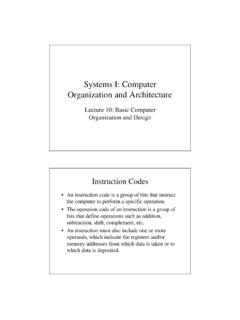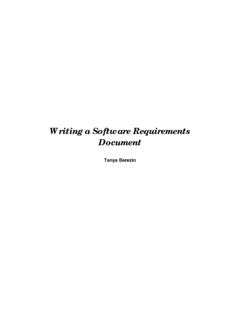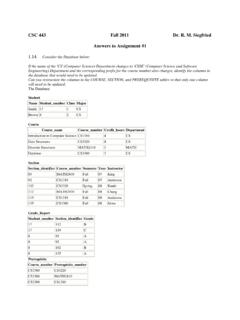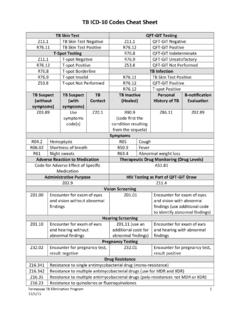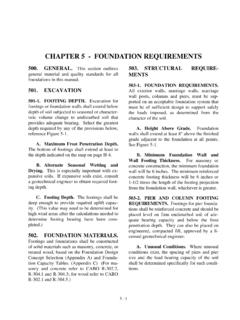Transcription of Systems I: Computer Organization and Architecture
1 Systems I: Computer Organization and ArchitectureLecture 10: Basic Computer Organization and DesignInstruction Codes An instruction code is a group of bits that instruct the Computer to perform a specific operation. The operation code of an instruction is a group of bits that define operations such as addition, subtraction, shift, complement, etc. An instruction must also include one or more operands, which indicate the registers and/or memory addresses from which data is taken or to which data is The instructions are stored in Computer memory in the same manner that data is stored. The control unit interprets these instructions and uses the operations code to determine the sequences of microoperationsthat must be performed to execute the Program Organization The operands are specified by indicating the registers and/or memory locations in which they are stored.
2 Kbits can be used to specify which of 2kregisters (or memory locations) are to be used. The simplest design is to have one processor register (called the accumulator) and two fields in the instruction, one for the opcodeand one for the operand. Any operation that does not need a memory operand frees the other bits to be used for other purposes, such as specifying different Program OrganizationOpcodeAddress0111215 Instruction formatBinary operand015 Memory4096 x 16 Instructions (programs)Operands(data)Processor Register(accumulator or AC)Addressing Modes There are four different types of operands that can appear in an instruction: Direct operand -an operand stored in the register or in the memory location specified. Indirect operand-an operand whose address is stored in the register or in the memory location specified. Immediate operand-an operand whose valueis specified in the and Indirect AddressingOpcodeAddress0111215 Instruction formatI14 ACOperand0 ADD457+ACOperand1 ADD300+13504573001350 IndirectaddressingDirectaddressingRegist ers Computer instructions are stored in consecutive locations and are executed sequentially; this requires a register which can stored the address of the next instruction; we call it the Program Counter.
3 We need registers which can hold the address at which a memory operand is stored as well as the value itself. We need a place where we can store temporary data the instruction being executed, a character being read in a character being written of Registers for the Basic ComputerRegisterSymbol # of Bits Register Name Function DR16 Data RegisterHolds memoryoperandAR12 Address RegisterHolds instructioncodePC12 Program CounterHolds instructionaddressTR16 TemporaryRegisterHolds temporarydataINPR8 Input RegisterHolds inputcharacterOUTR8 Output RegisterHolds outputcharacterBasic Computer Registers and MemoryPC011AR011IR015TR015 OUTR07 INPR07DR015AC015 Memory 4096 words16 bits per wordThe Common Bus To avoid excessive wiring, memory and all the register are connected via a common bus.
4 The specific output that is selected for the bus is determined by S2S1S0. The register whose LD (Load) is enable receives the data from the bus. Registers can be incremented by setting the INR control input and can be cleared by setting the CLR control input. The Accumulator s input must come via the Adder & Logic Circuit. This allows the Accumulator and Data Register to swap data simultaneously. The address of any memory location being accessed must be loaded in the Address Computer Registers Connected to a Common BusBusMemory4096 x 16 WriteReadARLDINRCLRPCLDINRCLRDRLDINRCLRA CLDINRCLRA dder& LogicEINPRIRLDTRLDINRCLROUTR7123465S2S1S 0Nb:All except INPR and Adder are connected to a clock pulseComputer Instructions The basic Computer has three instruction code formats: Memory-reference format where seven 3-bit opcodesare followed by a 12-bit memory address and preceded by a bit which indicates whether direct or indirect addressing is being used.
5 Register-reference format where 01112is followed by 12 bits which indicate a register instruction. Input-output format where 11112is followed by 12 bit which indicate an input-output instruction. In register-reference and I/O formats, only one of the lower 12 bits is Computer Instruction Formats011121415 IOpcodeAddressMemory-reference instructionOpcode= 000 through 1100111214150 1 1 1 Register operationRegister-reference instructionOpcode= 111, I = 00111214151 1 1 1I/O operationInput-output instructionOpcode= 111, I = 1 Instruction-Set Completeness A Computer instruction set is said to be complete if the Computer includes a sufficient number of instructions in each of these categories: Arithmetic, logical and shift instructions Instructions for moving data from registers to memory and memory to registers. Program-control and status-checking instructions Input and output instructionsArithmetic, Logic and Shifting Completeness We have instructions for adding, complementing and incrementing the accumulator.
6 With these we can also subtract. AND andcomplement provide NAND, from which all other logical operations can be constructed. We can construct logical and arithmetic shifts from the circular shift operations. We can construct multiply and divide from adding, subtracting and shifting. While this is complete, it is not very efficient; it would be to our advantage to have subtract, multiply, OR and Set Completeness (continued) We can perform moves using the LDA and STA instructions. We have unconditional branches (BUN), subprogram calls (BSA) and conditional branches (ISZ). We also have all the instructions we need to perform input and output and handle the interrupt that they Memory-Reference InstructionsSymbol I = 0 I = 1 Description AND0xxx8xxxAND mem. Wordto ACADD1xxx9xxxADD mem.
7 Wordto ACLDA2xxxAxxxLoad mem. Wordto ACSTA3xxxBxxxStore Content ofAC in and savereturn addressISZ6xxxExxxIncrement and skipif zeroHexadecimal codeBasic Register-Reference InstructionsSymbol Hex. code Description CLA7800 Clear ACCLE7400 Clear ECMA7200 Complement ACCME7100 Complement ECIR7080 Circulate right AC & ECIL7040 Circulate left AC & EINC7020 Increment ACBasic Register-Reference Instructions (continued)Symbol Hex. code Description SPA7010 Skip next instruction ifAC is positiveSNA7008 Skip next instruction ifAC is negativeSZA7004 Skip next instruction ifAC is zeroSZE7002 Skip next instruction if Eis zeroHLT7001 Halt computerBasic Input-Output InstructionsSymbol Hex.
8 code Description INPF800 Input character to ACOUTF400 Output character from ACSKIF200 Skip on input flagSKOF100 Skip on output flagIONF080 Interrupt onIOFF040 Interrupt offTiming and Control The timings for all the registers is controlled a master clock generator. Its pulses are applied to all flip-flops and registers, including in the control unit. The control signals are generated in the control unit and provide control inputs for the bus s mutlitplexersand for the processor registers and provides micrroperationsfor the There are two types of control: Hardwired control logic is implemented with gates, flip-flops, decoders and other digital circuits. Microprogrammed control information is stored in a control program, which is programmed to perform the necessary steps to implement Signals Timing signals are generated by the sequence counter (SC), which receives as inputs the clock pulse, increment and clear.
9 The SC s outputs are decoded into 16 timing signal T0through T15, which are used to control the sequence of operations. The RTL statement D3T4: SC 0resets the sequence counter to zero; the next timing signal is T0 Control Unit of Basic ComputerControlLogicGatesControloutputsO ther inputs1514 13 1211 -0 Instruction Register(IR)3 x 8decoder7 6 5 4 3 2 1 0D0D7150T15T04 x 16decoder4-bitsequence counter(SC)Increment(INR)Clear (CLR)ClockExamples of Control Timing SignalsClockT0T1T2T3T4T0T0T1T2T3T4D3 CLRSCI nstruction Cycle The instructions of a program are carried out by a process called the instruction cycle. The instruction cycle consists of these phases: Fetch an instruction from memory Decode the instruction Read the effective address from memory if the operand has an indirect address. Execute the and Decode Initially, the PC has stored the address of the instruction about to be executed and the SC is cleared to 0.
10 With each clock pulses the SC is incremented and the timing signals go through the sequence T0, T1, T2, etc. It is necessary to load the AR with the PC s address (it is connected to memory address inputs):T0: AR PCFetch and Decode Subsequently, as we fetch the instruction to be executed, we must increment the program counter so that it points to the next instruction: T1: IR M[AR], PC PC + 1 In order to carry out the instruction, we must decode and prepare to fetch the operand. In the event it is an indirect operand, we need to have the indirect addressing bit as well: T2:D0, ..D7 Decode IR(12-14), AR IR (0-11), I IR(15)Register Transfers For the Fetch PhaseBusMemory unit7 ARAddr1 ReadLDPCINRIRLDT1T025 ClockS2S1S0 Type of Instruction and Addressing During time T3, the control unit determines if this is a memory-reference, register-reference or input/output instruction.
